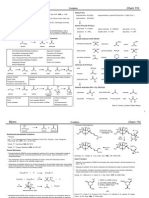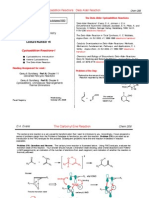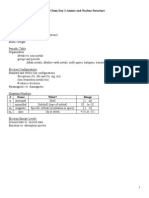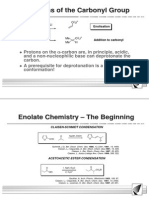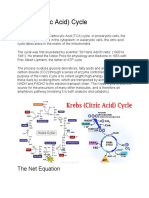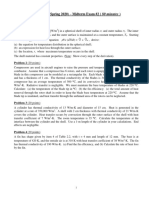Chem 115 Myers: Shi Asymmetric Epoxidation Reaction
Chem 115 Myers: Shi Asymmetric Epoxidation Reaction
Uploaded by
ashisdasCopyright:
Available Formats
Chem 115 Myers: Shi Asymmetric Epoxidation Reaction
Chem 115 Myers: Shi Asymmetric Epoxidation Reaction
Uploaded by
ashisdasOriginal Title
Copyright
Available Formats
Share this document
Did you find this document useful?
Is this content inappropriate?
Copyright:
Available Formats
Chem 115 Myers: Shi Asymmetric Epoxidation Reaction
Chem 115 Myers: Shi Asymmetric Epoxidation Reaction
Uploaded by
ashisdasCopyright:
Available Formats
Myers
Chem 115
Shi Asymmetric Epoxidation Reaction
Reviews:
Examples:
Wong, O. A.; Shi, Y. Chem. Rev. 2008, 108, 39583987.
1. Effect of smaller R1 (also known as "T-branch"; phenyl groups can be considered smaller than
methyl).
Shi, Y. Acc. Chem. Res. 2004, 37, 488496.
Frohn, M.; Shi, Y. Synthesis 2000, 14, 19792000.
H3C
General Transformation:
H3C
R1
R3
R2
CH3
O
R1
R2
R3
Useful for epoxidation of trans-disubstituted olefins (ketone 1), trisubstituted olefins (ketone 1),
conjugated cis-disubstituted olefins (ketone 2, see p. 3), and styrenes (ketone 2, see p. 3).
Catalyst Conditions:
H3C CH
3
H3C CH
3
O
H3C
O
O
CH3
Spiro
R3
O R
3
R2
O
H3C
R1
R2
Planar
Higher ee's are observed with smaller R1 and larger R3 substituents.
98% ee
CH3
H3C H3C CH3
91% ee
3. Comparing the size of R1 and R3.
Ph
Ph
CH3
76% ee
CH3
CH3
97% ee
Wang, Z.-X.; Tu, Y.; Frohn, M.; Zhang, J.-R.; Shi, Y. J. Am. Chem. Soc. 1997, 19, 1122411235.
Proposed Catalytic Cycle:
R1
R2
R1
R3
H3C
O
R3
CH3
HSO5
R2
O
O
H3C
O
H3C
CH3
H3C
O
H3C
CH3
O
O
O
H3C
CH3
H3C
CH3
H3C
C10H21
86% ee
O
O
81% ee
CH3
76% ee
H3C
Ketone 1 can be readily prepared from D-fructose ($15/kg) by ketalization (acetone, HClO4, 0
C, 53%) and oxidation (PCC, 23 C, 93%). L-Fructose can be prepared in 3 steps from
readily available L-sorbose.
Ketone 1 can be used catalytically (2030 mol %).
Oxone (a commercial mixture of 2:1:1 KHSO5:KHSO4:K2SO4) is used as the stoichiometric
oxidant but H2O2/CH3CN can also be used (peroxyimidic acid is the proposed oxidant).
Generally, the optimum pH for dioxirane epoxidation is 78. At higher pH, Oxone tends to
decompose. However, at pH 78 the Shi catalyst decomposes due to competing BaeyerVilliger reaction. By increasing the pH to 10.5 (by addition of K2CO3), the amount of ketone
used can be reduced to a catalytic amount (30 mol %) and the amount of Oxone can be
reduced to a stoichiometric amount (1.5 equiv), suggesting that at this pH the ketone is
sufficiently reactive to compete with Oxone decomposition.
Dimethoxymethane (DMM) and CH3CN (2:1 v/v) solvent mixtures generally provide higher
ee's.
Reaction temperatures range from 10 to 20 C.
It is proposed that the Shi epoxidation proceeds through a dioxirane intermediate and a spiro
transition state and that a so-called planar transition state is a main competing pathway. The
spiro transition state is believed to be electronically favored as a result of a stabilizing interaction
between an oxygen lone pair of the dioxirane with the !* orbital of the olefin.
O R
1
H3C
Ph
CH3
79% ee
2. Effect of larger R3 (also: "L-branch").
H3C
O
CH3
Ph
H3C
26% ee
oxone, pH 10.5, base
H2O, CH3CN
O
H3C
H3C
H3C CH3
O
SO42
CH3
O
OH
O O
SO3
CH3
O
O
H3C
O
CH3
O
CH3
O O
SO3
Soojin Kwon
Myers
Chem 115
Shi Asymmetric Epoxidation Reaction
Examples of Shi Epoxidations:
Regioselectivity increases when either olefin of a 1,3-diene is trisubstituted. It is proposed that
the trisubstituted olefin prevents full conjugation of the diene due to A1,2 strain, causing each
olefin to present an individual steric or electronic environment, as if each were isolated.
Substrate
Ph
Product
O
Ph
Ph
CH3
TMS
Ph
1, Oxone, K2CO3,
CH3CN, DMM
TMS +
Ph
O
Ph
TMS
93%
41%
93%
94%
89%
Yield
ee
Ratio
R=H
31%
95%
1:1
R = CH3
77%
92%
14:1
Ph
CH3
95%
61%
Frohn, M.; Dalkiewicz, M.; Tu, Y.; Wang, Z.-X.; Shi, Y. J. Org. Chem. 1998, 63, 29482953.
O
n-C10H21
73%
Cl
Ph
O
Ph
ee (%)
R
O
Cl
Ph
Ph
Yield
n-C10H21
CH3
CH3
Epoxidation of enynes occurs selectively at the CC double bond.
Tu, Y.; Wang, Z.-X.; Shi, Y. J. Am. Chem. Soc. 1996, 118, 98069807
and Wang, Z.-X.; Tu, Y.; Frohn, M.; Zhang, J.-R.; Shi, Y. J. Am. Chem. Soc. 1997, 119, 1122411235.
TMS
Ph
CH3
Monoepoxidation of conjugated dienes favors the more electron-rich or less sterically hindered
olefin. The amount of catalyst used must be properly controlled (0.20.3 equiv) to prevent bisepoxidation. Vinyl silanes and allylic silyl ethers are deactivated towards epoxidation
(attributed to sterics and inductive deactivation, respectively).
1, Oxone, K2CO3,
TMS
Ph
CH3CN, DMM
CH3
64%, 94% ee
Cao, G.-A.; Wang, Z.-X.; Tu, Y.; Shi, Y. Tetrahedron Lett. 1998, 39, 44254428.
Wang, Z.-X.; Cao, G.-A.; Shi, Y. J. Org. Chem. 1999, 64, 76467650.
CH3
OTBS
H3C
CH3
25 mol % 1, Oxone, K2CO3
CH3CN, DMM
OTBS
H3C
1,1-Disubstituted epoxides can be synthesized enantioselectively by Shi epoxidation of
trisubstituted vinyl silanes followed by TBAF-mediated desilyation.
81%, 96% ee
CH3
H3C
H3C
CH3
OCH3
20 mol % 1, Oxone, K2CO3
CH3CN, DMM
65%, 89% ee
O
H3C
H3C
CH3
OCH3
TMS
1, Oxone, K2CO3
CH3CN, DMM
CH3
O
74%, 94% ee
Warren, J.D.; Shi, Y. J. Org. Chem. 1999, 64, 76757677.
TMS TBAF
82%
CH3
O
94% ee
Soojin Kwon
Myers
A modified catalyst is useful for epoxidation of cis-disubstituted olefins and styrenes.
O
O
CH3
CH3
CH3
CH3
NBoc
O
H3C
Enol esters can be used as substrates for the preparation of !-hydroxyketones in either
enantiomeric form.
Ph
Chem 115
Shi Asymmetric Epoxidation Reaction
Ph
O
CH3
66%, 91% ee
Ph
Ph
OH
90%
CH3
CH3
Ph
91% ee
Oxone, K2CO3, DME, DMM
K2CO3, MeOH
O
CH3
94% ee
195 C, 0.5 h
82%, 91% ee
92%
The enantiomeric excess is generally high for cyclic olefins and for acyclic olefins conjugated with
an alkynyl or aromatic group.
O
Ph
Tian, H.; She, X.; Shu, L.; Yu, H.; Shi, Y. J. Am. Chem. Soc. 2000, 122, 1155111552.
CH3
K2CO3, MeOH
CH3
Ph
OAc
OH
O
O
88% ee
NBoc
Zhu, Y.; Tu, Y.; Yu, H.; Shi, Y. Tetrahedron Lett. 1998, 39, 78197822.
O
O
H3C
O
CH3
Kinetic resolution of racemic 1,3- and 1,6-disubstituted cyclohexenes can provide optically
enriched allylic silyl ethers.
Oxone, K2CO3, DME, DMM
100%, 81% ee
OTMS
Ph
Tian, H.; She, X.; Xu, J.; Shi, Y. Org. Lett. 2001, 3, 19291931.
Tian, H.; She, X.; Yu, H.; Shu, L.; Shi, Y. J. Org. Chem. 2002, 67, 24352446.
In both cases, it is proposed that the "-substituent of the substrate prefers to be proximal to the spiro
oxazolidinone.
NBoc
R"
R
O O 1
O
O
CH3 CH3
OTMS
Ph
OTMS
Ph
O
49% conversion
OTBS
96% ee
trans:cis >20:1
95% ee trans
OTBS
OTBS
35 mol % 1
O
O
35 mol % 1
Ph
70% conversion
Ph
99% ee
O
Ph
trans:cis 4:1
81% ee trans
Frohn, M.; Zhou, X.; Zhang, J.-R.; Tang, Y.; Shi, Y. J. Am. Chem. Soc. 1999, 121, 77187719.
Soojin Kwon
Myers
Chem 115
Shi Asymmetric Epoxidation Reaction
The original Shi catalyst decomposes (via the Baeyer-Villiger pathway) faster than it reacts with
electron-deficient !,"-unsaturated esters. A second-generation catalyst, incorporating electronwithdrawing acetate groups, slows the Baeyer-Villiger decomposition.
H3C
O
Cryptophycin 52:
The Shi epoxidation system provided the desired epoxide in a 6:1 diastereomeric ratio, while
other epoxidation methods never exceeded a 2:1 ratio.
CH3
CH3
Ph
OAc
CO2Et
Cl
OH
73%, 96% ee
CO2Et
Ph
OCH3
CCl3
Applications in Synthesis:
Conditions
",! ratio
Ketone 1
m-CPBA
6.5:1
1.5:1
H3C
dihydroxylation
CH3
HO CH3
CH3
OH
CH3
O
1, Oxone, DMM,
CH3
H3C
CH3CN, H2O,
piperidine, DMF
pH 10.5, 0 C, 1.5 h
79%
CH3
CH3
CH3
CSA, toluene, 0 C, 1 h
31% (2 steps)
OH
CH3
OH
H3C
CH3 H
H3C
CH3
H3C
H3C
H3C
CH3
O
O
O
HN
CH3
CH3 O
NHFmoc
CH3
OH
OH
O
71% (2 steps)
CH3
CH3
88% ee
HO CH3
CCl3
DMAP, DCC, CH2Cl2
CH3
H 3C
73%
HN
NHFmoc
O
H3C CH3
H3C
Glabrescol:
asymmetric
Wu, X.-Y.; She, X.; Shi, Y. J. Am. Chem. Soc. 2002, 124, 87928793.
squalene
CH3
Conditions
HN
OH
AcO
CH3 H
O
O
CH3 H CH3 H
H3C
Cl
O
OCH3
CCl3
CH3
O
O
HN
N
O
H
H3C CH3
Cl
O
OCH3
Cryptophycin 52
CH3
originally proposed structure of Glabrescol
Hoard, D. W.; Moher, E. D.; Martinelli, M. J.; Norman, B. H. Org. Lett. 2002, 4, 18131815.
Xiong, Z.; Corey, E. J. J. Am. Chem. Soc. 2000, 122, 48314832.
Soojin Kwon
Myers
Chem 115
Shi Asymmetric Epoxidation Reaction
Thyrsiferol:
Octalactin A:
Post epoxidation, only one bromohydrin diastereomer cyclized to the bromotetrahydropyran. The
unreactive diastereomer was separated from the cyclization product and isolated in 30% yield.
CO2CH3
TBSO
Ph3P, AcOH
CO2CH3
TBSO
80 C, 8 h
CH3
CH3
85%
H3C
30 mol % 1, Oxone
OAc
H3C
CH3
OTBS
CO2CH3
TBSO
1. Me3Al; H2O, 30 C,
2 h, 82%
O
TBSO
CH3
2. TBDMSCl, Im, 23 C,
2 d, 84%
(proposed)
HO
TBSO
CH3
OAc
Br
CH3
cat. CSA
CO2CH3
Et2O
50%
9096% ee
H
Br
O
O
HO
H3C
farnesyl acetate
H3C
H3C
OTBS
H3C
O
2. catalyst 1, Oxone,
DMM, CH3CN, H2O,
pH 10.5, 58%
K2CO3, 0 C, 6 h
45 %
1. NBS, THF, H2O, 67%
CH3
CH3 CH3
OH
CH3
CH3
CH3
H
OAc
H3C
H3C
OH
CH3
CH3
H
H
Br
OAc
OH
t-BuOOH, cat. Ti(O-i-Pr)4
(+)-diethyl tartrate, CH2Cl2
CH3
99%
Octalactin A
Bluet, G.; Campagne, J.-M. Synlett 2000, 1, 221222.
H3C
H3C
H
Br
CH3
H
OAc
CH3
O
OH
>95% de
(proposed)
H3C
H3C
H3C
CH3
H
Br
McDonald, F. E.; Wei, X. Org. Lett. 2002, 4, 593595.
HO CH3 H3C
H
H
O
HO H
CH3
HO CH3
H
Thyrsiferol
Soojin Kwon
You might also like
- Asymmetric SynthesisDocument55 pagesAsymmetric Synthesisevsgoud_goud0% (1)
- Lecture 5 - Stereoelectronic Effects On ReactivityDocument19 pagesLecture 5 - Stereoelectronic Effects On Reactivityhoang12310100% (1)
- Schaum's Easy Outline of Organic Chemistry, Second EditionFrom EverandSchaum's Easy Outline of Organic Chemistry, Second EditionRating: 3.5 out of 5 stars3.5/5 (2)
- Tenaris Connection Catalogue, 2014Document136 pagesTenaris Connection Catalogue, 2014zhiqianxu50% (2)
- 28 CyclopropanationDocument11 pages28 CyclopropanationRajesh TammanaNo ratings yet
- Chem 215 Myers: The Heck ReactionDocument8 pagesChem 215 Myers: The Heck ReactiondubstepoNo ratings yet
- 16 Sharpless Asymmetric EDocument4 pages16 Sharpless Asymmetric ENicolò MarnoniNo ratings yet
- Ferreira Lit 7-17-03Document14 pagesFerreira Lit 7-17-03bocahupiNo ratings yet
- Chapter04 OxidationdDocument46 pagesChapter04 OxidationdWilliam H. BasingerNo ratings yet
- 05 Conformational Anal 2Document11 pages05 Conformational Anal 2Swati GautamNo ratings yet
- Chemical Change: Dr. Suzan A. Khayyat 1Document95 pagesChemical Change: Dr. Suzan A. Khayyat 1Chandra ReddyNo ratings yet
- Oxidation Reactions of Organic ChemistryDocument28 pagesOxidation Reactions of Organic ChemistryviejayNo ratings yet
- Oxidation (Myers)Document10 pagesOxidation (Myers)YouTibeNo ratings yet
- Shi EpoxidationDocument5 pagesShi EpoxidationJia Yuan ChngNo ratings yet
- Chem 115 Myers: Birch ReductionDocument7 pagesChem 115 Myers: Birch ReductionNimz02No ratings yet
- Chem 215 Myers: Birch ReductionDocument7 pagesChem 215 Myers: Birch ReductionPrasanna AndojuNo ratings yet
- 16 Cycloaddition Rxns 1Document13 pages16 Cycloaddition Rxns 1Aulia RhamdaniNo ratings yet
- Bi FunctionalDocument36 pagesBi FunctionalchidambaramrNo ratings yet
- Guidelines For EpoxidationDocument27 pagesGuidelines For EpoxidationSony SinghNo ratings yet
- Compendium On Problems in Physical-Organic ChemistryDocument27 pagesCompendium On Problems in Physical-Organic ChemistrychemptnkNo ratings yet
- Suzuky ReactionDocument13 pagesSuzuky ReactionAlbornoz JuanNo ratings yet
- hantzsch-thiazole-synthesis-2010Document5 pageshantzsch-thiazole-synthesis-2010Nasir MehmoodNo ratings yet
- HC9780851865621 00001Document91 pagesHC9780851865621 00001Anand MurugananthamNo ratings yet
- General Chemistry ReviewDocument15 pagesGeneral Chemistry ReviewPhirun ChengNo ratings yet
- wang 1998Document3 pageswang 1998javeriababar93No ratings yet
- 9 Lithium HalogenDocument3 pages9 Lithium HalogenAndy ChengNo ratings yet
- Carbenoids 2Document15 pagesCarbenoids 2costea0028No ratings yet
- Olefin Metathesis in Organic SynthesisDocument19 pagesOlefin Metathesis in Organic SynthesisaegosmithNo ratings yet
- Chem 215 Myers: The Suzuki ReactionDocument10 pagesChem 215 Myers: The Suzuki ReactionRajathi YadavNo ratings yet
- Art:10.1007/s10562 005 7999 8Document7 pagesArt:10.1007/s10562 005 7999 8Yassine SabekNo ratings yet
- 2005-Sonochemistry and Its DosimetryDocument6 pages2005-Sonochemistry and Its DosimetryOualid HamdaouiعععNo ratings yet
- Anti Baldwin CyclizationsDocument14 pagesAnti Baldwin CyclizationsLeandro SasiambarrenaNo ratings yet
- Ultrasonics Sonochemistry: Yan-Jiang Bian, Wei-Li Xue, Xu-Guang YuDocument3 pagesUltrasonics Sonochemistry: Yan-Jiang Bian, Wei-Li Xue, Xu-Guang YuTúlio CoutoNo ratings yet
- Pericyclic Reactions PDFDocument41 pagesPericyclic Reactions PDFnofacejack67% (3)
- Lecture 23: Enolates and C-C Bond Formation Enolates and C-C Bond FormationDocument16 pagesLecture 23: Enolates and C-C Bond Formation Enolates and C-C Bond FormationMiguel Divino da RochaNo ratings yet
- Mechanism of Cannizzaro ReactionDocument8 pagesMechanism of Cannizzaro ReactionDaniel LieNo ratings yet
- Enola TesDocument21 pagesEnola TesReksy WibowoNo ratings yet
- CH 07Document96 pagesCH 07Jacquot AbendrothNo ratings yet
- Generation and Characterization of 1,2-Diaryl-1,1,2,2-Tetramethyldisilane Cation RadicalsDocument6 pagesGeneration and Characterization of 1,2-Diaryl-1,1,2,2-Tetramethyldisilane Cation RadicalsDiogomussumNo ratings yet
- CiclobencenoDocument8 pagesCiclobencenoChuck ÜbermenschNo ratings yet
- Organic ChemistryDocument41 pagesOrganic ChemistrySunil ChoudharyNo ratings yet
- Agostic Bani Seminar2Document47 pagesAgostic Bani Seminar2Arif SajjadNo ratings yet
- Jcpsa6 24 3 559 1Document12 pagesJcpsa6 24 3 559 1eddyterryNo ratings yet
- Proteins and Amino Acids PreDocument6 pagesProteins and Amino Acids PreKarina KhanNo ratings yet
- Hydrolysis 2006Document20 pagesHydrolysis 2006ashoifulNo ratings yet
- Conjugated DienesDocument80 pagesConjugated Dienestrie_79No ratings yet
- The Pinacol-Pinacolone RearrangementDocument9 pagesThe Pinacol-Pinacolone RearrangementParag MehtaNo ratings yet
- Mcclory-Lit-03 16 09Document58 pagesMcclory-Lit-03 16 09Vasudevan SubramaniyanNo ratings yet
- Chen Feb 07Document9 pagesChen Feb 07Debdeep RayNo ratings yet
- Exam Chemistry 2022Document2 pagesExam Chemistry 2022bloodvjp68No ratings yet
- CyC - Propuesta 1 de PIADocument11 pagesCyC - Propuesta 1 de PIAKike SalasNo ratings yet
- Artigo - Vitamina EDocument10 pagesArtigo - Vitamina EGiselle FlorianoNo ratings yet
- Chem 215 Myers: Sharpless Asymmetric Dihydroxylation ReactionDocument4 pagesChem 215 Myers: Sharpless Asymmetric Dihydroxylation ReactionPrabhakar S AchantaNo ratings yet
- Important Long and Short Answer Questions For EC Exam-Dr Mallesham GDocument7 pagesImportant Long and Short Answer Questions For EC Exam-Dr Mallesham Gshivamani1489No ratings yet
- Catalase: Hans LuckDocument10 pagesCatalase: Hans LuckNguyễn QuangNo ratings yet
- Alcohols-Structure and Synthesis 2Document82 pagesAlcohols-Structure and Synthesis 2Diana Cárdenas MuñozNo ratings yet
- Chapter 6 NotesDocument21 pagesChapter 6 NotesJesús Adrián Gómez OrtizNo ratings yet
- Hydrozirconation - Final 0Document11 pagesHydrozirconation - Final 0David Tritono Di BallastrossNo ratings yet
- 06 Conformational Anal 3Document13 pages06 Conformational Anal 3eraborNo ratings yet
- Practice Makes Perfect in Chemistry: Acids, Bases, and Salts with AnswersFrom EverandPractice Makes Perfect in Chemistry: Acids, Bases, and Salts with AnswersNo ratings yet
- Kreb CycleDocument6 pagesKreb Cycle211BT014 Jeev Sheen JosephNo ratings yet
- 1-SCH 201 Chemical Thermodynamics-2016.by HON - Steve TOSHDocument49 pages1-SCH 201 Chemical Thermodynamics-2016.by HON - Steve TOSHritahmunyetiNo ratings yet
- Sciencedirect Sciencedirect SciencedirectDocument5 pagesSciencedirect Sciencedirect SciencedirectMazurchevici Andrei DănuţNo ratings yet
- Linear Free Energy RelationshipsDocument4 pagesLinear Free Energy RelationshipsManP13No ratings yet
- Chem 2241 MidtermDocument11 pagesChem 2241 MidtermTsz Wun CHOWNo ratings yet
- Temperature Compensation in PH Meter-A Survey: April 2015Document10 pagesTemperature Compensation in PH Meter-A Survey: April 2015Deepakrao Bornare PatilNo ratings yet
- A91a00230gus Diluent 10l 20lDocument10 pagesA91a00230gus Diluent 10l 20lNurhadi KebluksNo ratings yet
- MVR MSFDocument2 pagesMVR MSFBaba DookNo ratings yet
- CHEMISTRY PRACTICAL SSC-23 RevisedDocument4 pagesCHEMISTRY PRACTICAL SSC-23 Revisedtalhaaslam7516034No ratings yet
- Critical Reviews in Food Science and NutritionDocument14 pagesCritical Reviews in Food Science and NutritionAmit Kr GodaraNo ratings yet
- Separations Based On The Motion of Particles ThroughDocument16 pagesSeparations Based On The Motion of Particles ThroughRA Memije0% (1)
- Power Production Using Leidenfrost EffectDocument13 pagesPower Production Using Leidenfrost EffectMini VargheseNo ratings yet
- Weekly Lesson Plan (From 19/3/2023 To 23/3/2023) : Math Biology Chemistry Physics EnglishDocument2 pagesWeekly Lesson Plan (From 19/3/2023 To 23/3/2023) : Math Biology Chemistry Physics EnglishMohammad DyabNo ratings yet
- L14 20 T7 9 MOS With SolutionsDocument115 pagesL14 20 T7 9 MOS With SolutionsJithin SreeshanNo ratings yet
- AEEE 2024 Sample PaperDocument98 pagesAEEE 2024 Sample Paperaiswaryasakthivel007100% (1)
- Chemiluminescnece Final Lab ReportDocument10 pagesChemiluminescnece Final Lab ReportSanzida TaslimNo ratings yet
- Impression Material 2Document104 pagesImpression Material 2Manjulika Tysgi100% (1)
- STORK Dea EratorDocument26 pagesSTORK Dea EratorSarmad Ali ShahNo ratings yet
- Immunoassay CompleteDocument56 pagesImmunoassay CompleteIndira100% (1)
- Charantin A Neglected Antidiabetic Compound From Momordica Charantia L PDFDocument6 pagesCharantin A Neglected Antidiabetic Compound From Momordica Charantia L PDFEnieNo ratings yet
- Department of Automobile Engineering At8091 - Manufacturing of Automotive ComponentsDocument11 pagesDepartment of Automobile Engineering At8091 - Manufacturing of Automotive ComponentsERKATHIRNo ratings yet
- Compartment ModellingDocument46 pagesCompartment ModellingBio DataNo ratings yet
- ID-PRC 21 - Anti-Corrosion Wrapping UG Steel PipingDocument10 pagesID-PRC 21 - Anti-Corrosion Wrapping UG Steel Pipingcloud23No ratings yet
- 04 - The Fluorescence MicroscopeDocument8 pages04 - The Fluorescence MicroscopeRadu EcaterinaNo ratings yet
- Department of Chemistry: Michael J. HynesDocument55 pagesDepartment of Chemistry: Michael J. HynesAndrés PacompíaNo ratings yet
- MAE 101C (Spring 2020) - Midterm Exam #2: Problem 1 (20 Points)Document1 pageMAE 101C (Spring 2020) - Midterm Exam #2: Problem 1 (20 Points)Dinger RectileNo ratings yet
- Boiler RoomDocument1 pageBoiler RoomtylerstearnsNo ratings yet
- Important Reagents TreDocument3 pagesImportant Reagents Treraghava123456No ratings yet
- Calculating Weld Volume and WeightDocument4 pagesCalculating Weld Volume and WeightRAKESHNo ratings yet











